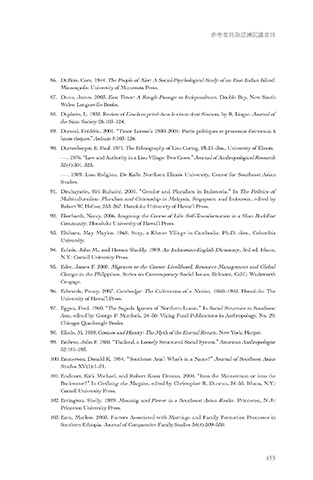Page 455 - 東南亞的日常生活風貌
P. 455
東南亞的日常生活風貌 參考書目與建議閱讀書目
–. 2005. “Thai Buddhist Monks.” In Encyclopedia of Religion and Nature, Vol. 2, 1629–1630. 86. DuBois, Cora. 1944. The People of Alor: A Social-Psychological Study of an East Indian Island.
New York: Continuum International Pubs. Minneapolis: University of Minnesota Press.
–. 2007. “The Good Buddha and the Fierce Spirits: Protecting the Northern Thai Forest.” 87. Dunn, James. 2003. East Timor: A Rough Passage to Independence. Double Bay, New South
Contemporary Buddhism 8(2):169–185. Wales: Longueville Books.
–. 2009. “Translating Modernity: Buddhist Response to the Thai Environmental Crisis.” In 88. Duplatre, L. 1933. Review of L’esclave privé dans le vieux droit Siamois, by R. Lingat. Journal of
TransBuddhism: Transmission, Translation and Transformation, edited by Abraham Zablocki, Jay the Siam Society 26:103–124.
Garfield, and Nalini Bhushan, 183–207. Amherst: University of Massachusetts Press. 89. Durand, Frédéric, 2001. “Timor Lorosa’e 1930–2001: Partis politiques et processus électoraux à
–. Forthcoming. The Ordination of a Tree: The Thai Buddhist Environmental Movement. hauts risques.” Aséanie 8:103–126.
Albany: SUNY Press. 90. Durrenberger, E. Paul. 1971. The Ethnography of Lisu Curing. Ph.D. diss., University of Illinois.
78. Davis, Erik. 2009. Buddhism Makes Brahmanism: Entities and Erotics in Cambodian Religion. –. 1976. “Law and Authority in a Lisu Village: Two Cases.” Journal of Anthropological Research
Talk given at the Southeast Asian Summer Studies Institute, Madison, Wis. July 25. 32(4):301–325.
79. Delcore, Henry D. 2004. “Symbolic Politics or Generification? The Ambivalent Implications of –. 1989. Lisu Religion. De Kalb: Northern Illinois University, Center for Southeast Asian
Tree Ordinations in the Thai Environmental Movement.” Journal of Political Ecology 11(1):1–30. Studies.
80. Dentan, Robert Knox. 1975. “If There Were No Malays, Who Would the Semai Be?” In 91. Dzuhayatin, Siti Ruhaini. 2001. “Gender and Pluralism in Indonesia.” In The Politics of
Pluralism in Malaysia, edited by Judith Nagata. Contributions to Asian Studies 7:50–64. Multiculturalism: Pluralism and Citizenship in Malaysia, Singapore, and Indonesia, edited by
–. 1976. “Identity and Ethnic Contact: Perak, Malaysia, 1963.” In Intergroup Relations: Asian Robert W. Hefner, 253–267. Honolulu: University of Hawai’i Press.
Scenes, edited by Tai S. Kang. Journal of Asian Affairs 1(1):79–86. 92. Eberhardt, Nancy. 2006. Imagining the Course of Life: Self-Transformation in a Shan Buddhist
–. 1997. “The Persistence of Received Truth: How the Malaysian Ruling Class Constructs Community. Honolulu: University of Hawai’i Press.
Orang Asli.” In Indigenous Peoples and the State, edited by Robert Winzeler. Monograph 46/Yale 93. Ebihara, May Mayko. 1968. Svay, a Khmer Village in Cambodia. Ph.D. diss., Columbia
University Southeast Asia Studies. New Haven, Conn.: Yale University. University.
–. 2001. “A Vision of Modernization.” Anthropology and Humanism 26(1):3–15. 94. Echols, John M., and Hassan Shadily. 1989. An Indonesian-English Dictionary, 3rd ed. Ithaca,
–. 2008. Overwhelming Terror. Boulder, Colo.: Rowman and Littlefield. N.Y.: Cornell University Press.
–. 2010. “Nonkilling Social Arrangements.” In Nonkilling Societies, edited by J. C. Evans-Pym. 95. Eder, James F. 2008. Migrants to the Coasts: Livelihood, Resource Management and Global
Honolulu: Center for Global Nonkilling. Change in the Philippines. Series on Contemporary Social Issues. Belmont, Calif.: Wadsworth
–. Forthcoming. “Childhood, Familiarity and Social Life among East Semai.” In Anarchic Cengage.
Solidarity: Autonomy, Equality, and Fellowship in Southeast Asia, edited by Thomas Gibson and 96. Edwards, Penny. 2007. Cambodge: The Cultivation of a Nation, 1860–1945. Honolulu: The
Kenneth Sillander. New Haven, Conn.: Yale Southeast Asian Studies Publications. University of Hawai’i Press.
–, and Juli Edo. 2008. “Schooling vs. Education, Hidden vs. Overt Curricula.” Moussons 12(1– 97. Eggan, Fred. 1960. “The Sagada Igorots of Northern Luzon.” In Social Structure in Southeast
2):3–34. Asia, edited by George P. Murdock, 24–50. Viking Fund Publications in Anthropology, No. 29.
–, and Robert Knox, Kirk Michael Endicott, Alberto G. Gomes, and M. Barry Hooker. 1997. Chicago: Quadrangle Books.
Malaysia and the “Original People.” Boston: Allyn and Bacon. 98. Eliade, M. 1959. Cosmos and History: The Myth of the Eternal Return. New York: Harper.
81. Department of Museums. n.d. (a). Worshipping Ceremony of the Mah Meri Aboriginal Tribe. 99. Embree, John F. 1950. “Thailand, a Loosely Structured Social System.” American Anthropologist
(CD) Kuala Lumpur: Ministry of Culture of Malaysia. 52:181–193.
–, n.d. (b). The Art of Wood Carving of the Orang Asli. (CD) Kuala Lumpur: Ministry of 100. Emmerson, Donald K. 1984. “‘Southeast Asia’: What’s in a Name?” Journal of Southeast Asian
Culture of Malaysia. Studies XV(1):1–21.
–, n.d. (c). Sewang (Semai Ethnic). (CD) Kuala Lumpur: Ministry of Culture of Malaysia. 101. Endicott, Kirk Michael, and Robert Knox Dentan. 2004. “Into the Mainstream or into the
82. Dessaint, Alain Y. 1972. “Lisu Settlement Patterns.” Journal of the Siam Society 60:195–204. Backwater?” In Civilizing the Margins, edited by Christopher R. Duncan, 24–55. Ithaca, N.Y.:
83. Dessaint, William, and Alain Y. Dessaint. 1992. “Opium and Labor: Social Structure and Cornell University Press.
Economic Change in the Lisu Highlands. Peasant Studies (Salt Lake City) 19(3):147–177. 102. Errington, Shelly. 1989. Meaning and Power in a Southeast Asian Realm. Princeton, N.J.:
Princeton University Press.
84. Djamour, Judith. 1965. Malay Kinship and Marriage in Singapore. London: Athlone Press.
85. Drowned Forests, Damned Lives. n.d. (CD). Center for Orang Asli Concerns. Subang Jaya, 103. Ezra, Markos. 2003. Factors Associated with Marriage and Family Formation Processes in
Southern Ethiopia. Journal of Comparative Family Studies 34(4):509–530.
Selangor: COAC.
452 453

